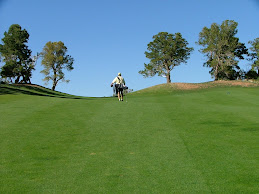The word “unique” is frequently employed as a descriptive term for golf courses that are thought to possess one of a kind settings and layouts. Truth is any course which deviates slightly from the traditional or the accepted is given the unique moniker. It becomes difficult to designate well-deserved courses as special in regard to setting and design. Discretion in labeling golf courses is crucial. Every golf course designed and constructed cannot be extra special. On the other hand it is important not to overlook those that are obviously in the one-of-a-kind category. Such is the case for Old Works Golf Course in Anaconda, Montana.
There has been no shortage of acclaim for the Jack Nicklaus design which opened in 1996 and has consistently been included on every Top 100 Public Golf Course list. GolfWeek selects it as the best in the entire state. Golf Digest places Old Works at number 82 on its list of America's 100 Greatest Public Courses. These lofty evaluations are not mistakes or overestimations. Old Works lives up to its accolades and to our high expectations with an extremely interesting layout, excellent course conditions, friendly staff and the best darn price.
Carved throughout an abandoned copper mine, Nicklaus has truly created a work of art. And it is the copper mine that provides the fascination and the ambiance of the layout. Visions of its former existence are virtually everywhere beginning at the first tee box with the display of two huge smelters which have been turned into planters. The par 5 third and the par 3 fourth play parallel to the deteriorating stone furnaces. And the “sand” in the bunkers is not really sand at all; rather it's black slag.
 First tee at Old Works
First tee at Old WorksOld Works contains a first-rate practice facility that includes a range, putting green and practice green for chipping and bunker play. These are all conveniently located near the first tee. Nicklaus has also incorporated a very practical warm-up feature, a three hole course that circles the practice range. It gives you the opportunity to get a feel for the lay of the land, the greens and the bunkers.
With five sets of tee boxes appropriately dubbed Slag, Gold, Copper, Limestone and Brick, Old Works allows every golfer to play the course at a length which is comfortable yet challenging. Each tee is appropriated with the properly coordinated color tee markers. The Slag plays the longest at 7705 yards and the Brick the shortest at 5348 yards. While that may appear to be a bit lengthy, don't forget to allow for the elevation of Anaconda, almost a mile above sea level. The elevation and the fact that several holes play from elevated tee boxes make the course playable for everyone. The front nine has dramatic elevation changes as the course climbs and descends and twists and turns around the remaining mounds and hills of the old copper mine. From the fourth tee, the highest point on the golf course, you can overlook the entire front nine and a couple of holes on the back. The view is striking and gives a good perspective on what Nicklaus has done with the property. The back nine is relatively flat and has a totally different feel from the front. Approach shots on the par 4 tenth and the par 5 eleventh require a carry over a meandering creek that runs along the right side of #10 and the left side of #11. These are the only holes on the course which require a forced carry. Every other hole offers an opening to the green.
The course makes minimal demands from the tee presenting wide fairways that stretch out even wider in the landing areas. Hitting the fairways from the beautifully maintained tee boxes (We've played on some greens that were not as well groomed.) is not the dilemma. The difficulty of the course comes on the approach shots to the extra large, undulating greens that usually putt to a speed of 10 or 11 on the stimpmeter. Despite the wide fairways, it is critical to position the tee shot properly to allow for the best angle of approach into the greens. Misplaced tee shots will set up approach shots that must carry bunkers or present odd angles to the greens. This combination make the course fair yet at the same time challenging.
The front nine contains several interesting holes. The par 5 third is an uphill do

gleg right that tempts you to cut the corner on your second shot. The approach shot is to a two level green with the lower part in the back. The hole also plays along the remains of the old brick furnaces. The fourth is par 3 that plays slightly uphill with more mine remnants in the background. The most fascinating and spectacular hole on the front nine is the par 3 seventh which plays to a maximum of 238 yards. But the yardage is deceiving. The tee box sits atop of what seems like a small mountain of slag and the hole plays about fifty feet downhill across a huge bunker of the signature black slag sand. The mountains in the distance also provide a nice backdrop for the hole.
We found the tenth and eleventh to be best holes on the back. Number ten is a par four that curves slightly to the right with the creek along the right and then cutting in front of the green. The fairway appears narrow from the tee, but the landing area is generous as with all the other holes. The hole plays a little longer than the given yardage and the approach shot is very intimidating. It will make you play long or right to avoid the creek. The par 5 eleventh entices you to hit it long for two shots. At that point the fairway turns to the left and you must thread your approach through an opening in the trees and over the same creek you just negotiated at number 10. The fairway is wide but the approach must be precise to the very shallow green. The most difficult holes on the course is number sixteen. It's a long, uphill par 4 that usually plays into the wind. There's a lake on the right that shouldn't come into play, but is quite visible from the tee.
Old Works is a must play. The quality and the “unique” setting of the golf course, the friendliness of the staff, and the downright bargain price (always less than $50) make this a definite stop. And while Anaconda, Montana might not be the ultimate golf resort destination, it does have two other golf courses to offer: Anaconda Country Club and Fairmont Hot Springs Golf Course. It's a small town with a big golf feel.





